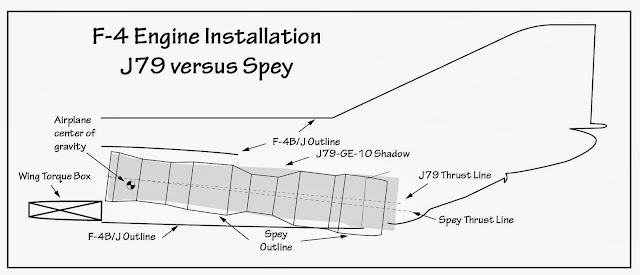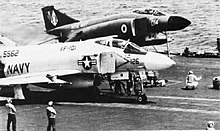Pirate Pete
ACCESS: Secret
- Joined
- 25 July 2007
- Messages
- 351
- Reaction score
- 586
If that flew as pretty as it looks, well, no wonder it had a bad reputation!Just in case anyone here is unfamiliar with the aesthetic abomination that the Seamew was….
I played with the statistics for British steam catapults in David Hobbs British Aircraft Carriers book and this was the result.
That's funny-peculiar because I expected the 151ft BS.5 to be more powerful than all versions of BS.4. (That is, with the possible exception of the 175ft stroke BS.4 fitted to Hermes 1964-66.) Instead (with the exception of Centaur) all varieties of BS.4 could launch aircraft that were just as heavy at slightly higher end speeds.
AIUI the bow BS.5s on Ark Royal & Eagle could launch a full-loaded F-4K.
If that's true and the information in the table is accurate the BS.4s on Hermes & Victorious could launch fully-loaded F-4Ks too. In fact they might do it more easily due to having slightly higher end speeds.
After 50 AH RN carrier threads and 24,856 posts we finally get to the nub of the RN carrier fantasy.The Spey Phantom alone would take up ~1/4 of the RNs capital equipment budget 1964-71, leaving aside Buccaneers, helicopters and of course ships!
After 50 AH RN carrier threads and 24,856 posts we finally get to the nub of the RN carrier fantasy.
It costs a lot of money and there just isn't enough resource given all the other demands. The RN were fortunate that they didn't have to foot the Polaris bill at the same time.
I read the other day that if the Services combined spending plans for the 1980s had become reality that 18% of the entire population would have had to be employed in the MIC.
And when the Admirals said they needed half a billion quid to build a fleet that could last 4 days of combat it's not surprising that the politicians said "nah thanks".



yup... many, many things in these pages. We covered this.Something that might be more significant that is recognised, if indeed if it is even known at all, is the thrust line of the Spey installation. Compared to the J79 the thrust line of the Spey is downward by 2 degrees.
The extended nose oleo gave the F4K an upward attitude of 9 degrees, more than the USN F4s already noticeable nose up attitude for launch (guessing 5 or 6 degrees?). The combination of the extended nose oleo and 2 degrees downward thrust line for the Spey might double the amount of lift the engine provides on launch compared to the standard J79 installation.
View attachment 757153

The Spey-Powered Phantom Changes
18 November 2016: For a note on F-4K XT-595 first flight markings, see http://tailhooktopics.blogspot.com/2016/11/f-4k-first-flight-marking...tailhooktopics.blogspot.com
View attachment 757152
Photo from Wiki.
RoC/Hood, #645/6. Labour torpedoed criticism of '65 US $ spend, claiming the total package (C-130/F-4K/M) cost little more, 1964-70, than the inherited Tory prog.. That had 5 SSBNs and upfront cash F-4Ks. Labour's package had deferred $ spend (at 4.75% interest).
My "Nah thanks" comment was in relation to the implied bill in 1978-79 for the 1980s fleet.So, Hood, #646, nah thanks, half-a-billion: IIRC that same number would feature in 1966 EoS, "CV or land bases".
Error did I miss that ? What reference?There is another spin off - during the negotiations the RN accepts Healey's (and the Treasury's) 35,000-ton carrier compromise
There is another spin off - during the negotiations the RN accepts Healey's (and the Treasury's) 35,000-ton carrier compromise (not so crazy when you consider CVA-01 was pushing the limits of shipbuilding capability and none of the yards were that keen on actually building it given the likely cost overruns and lack of profit).
This means a redesign, but its possible it may have been ordered by 1970, before Heath's government comes into power.
Error did I miss that ? What reference?
Well Victorious in tonnage, so there is nothing stopping a new design from having a 151ft at the bow and a 199ft at the waist and rated for aircraft upto 60,000lb.Does 35,000 tons impact on length and cats?
Well Victorious in tonnage, so there is nothing stopping a new design from having a 151ft at the bow and a 199ft at the waist and rated for aircraft upto 60,000lb.

Ok first many thanks for your contribution and sharing that picture.In the mid 1950s DNC thought that a 35,000 ton ship would have a maximum take-off weight limitation of 40,000lbs if a balanced design was to be maintained. Only by sacrificing other features such as ship armament, protection, speed and endurance could higher take-off weights be attained. Things would have moved on, but dramatically, in the following decade. A 1950s 35,000 ton CV concept is attached, note the "or longer" for the waist catapult.
View attachment 757467
I think that a longer Cat can put in the other side. Like the Ark. her instalation do not interferes with the lift.In the mid 1950s DNC thought that a 35,000 ton ship would have a maximum take-off weight limitation of 40,000lbs if a balanced design was to be maintained. Only by sacrificing other features such as ship armament, protection, speed and endurance could higher take-off weights be attained. Things would have moved on, but not dramatically, in the following decade. A 1950s 35,000 ton CV concept from DNC is attached, note the "or longer" for the waist catapult.
View attachment 757467

No, not Healey's idea but he allowed it to be offered and didn't crush the idea and he was running the show.The Maritime Role Carrier, it wasn't Healey's idea. Ed Hampshire is a big advocate, I understand why, Healey would have accepted it and it could have solved the immediate issue of cost by getting a naval programme within the then proposed financial constraints. The Navy came up with a 40,000 ton concept that would have carried 12 Phantoms and 8 Buccaneers, but it didn't work out much cheaper than CVA-01.
However, the resultant small ship with a small air wing would have been an easy target for RAF lobbying. Come the need for further cuts in 1968 its easy to see a large cost item in the forward programme coming under sustained RAF attack for not being cost effective compared to land based aircraft in the maritime role, resulting in its cancellation.
I think it could have lived - it would have meant the death of the CCH/CAH/CVS/CVSG - call it what you will - but having a commitment to it might have protected it. It wouldn't be much cheaper but it might have prevented some of the bloat in CVA-01 and ultimately we can't say how much CVA-01 would have cost over its estimates.
It would have been less impressive than CVA-01 in terms of capabilities but by the time these ships would have completed in the mid to late 1970s it would have mattered far less given the other V/STOL options open by then. And yes I can imagine it would grow to something like 40,000 tons - the Command Cruiser underwent a similar metamorphis.
You don't want a portside bow catapult in a ship that short, it puts anything getting launched off in the way of aircraft landing.I think that a longer Cat can put in the other side. Like the Ark. her instalation do not interferes with the lift.
the waist said 151. So 2 x 151 or 1x 199 and 151
View attachment 757471
Sadly Operation Musketeer was doomed to fail whenever it took place. Egypt had succeeded only a few years previously in forcing the UK to withdraw one of its largest garrisons. Eisenhower repeatedly warned Eden that the US would oppose UK military action. As in 2003 in Iraq the UK had no plan to cope with the occupation of the Canal Zone. Nasser was no Saddam and Egyptians were behind him all the way.Bear with me while I draw a long bow, from things I read ages ago and have just remembered.
The counter to this is Britain selects carrier strike warfare to deal with the Soviets in 1948-49. The 1953 global strategy paper is released, the RN is well placed to quickly meet the new requirements. In 1956 3 carriers are off Egypt within a month, and the canal is seized within 5 weeks with little international opposition, no run on the pound etc. Britain enters the late 50s full of confidence, with countries in the Mid East and elsewhere clamouring to buy its kit and be its ally. The 1957 Defence White Paper is a measured document, incorporating the lessons of Korea and Suez while reflecting the financial realities of the day and includes a carrier replacement programme to begin at short notice.
- The loss of Suez was a massive shock to Britain, it caused major problems with Defence policy and procurement.
- Suez failed because it took too long to mount, world opinion turned on Britain etc because the shock had died down and the canal was working.
- Musketeer took too long because Britain only had a single carrier in commission at home, it took months to get 3 available.
- There was only a single carrier available in 1956 because the 1948 Defence strategy focused on escorts to defend against the Soviet sub threat.
Paradoxically Suez spurred the acquisition of better amphibious warfare vessels for the RN.
The use of helicopters on Ocean and Theseus led to Albion and Bulwark being converted to specialised Commando Ships.
The ragtag LST force was replaced in due course by two LPDs (Fearless and Intrepid) and the five Knight class.
It had, however, no impact on the size and composition of the carrier force.
However it might have been good to make that transition without the drastic 100m budget cut and the cancellation of the RNs supersonic fighter project
The SR177 deserved to be cancelled. It was another disaster waiting to happen.
Sadly the RN did not learn from it and develop something sensible.
It would change things had F.177RN gone ahead. These would enter service between '62 to '65.
Though how changed from the '57 design freeze for the prototype, is an open question.
A revised design seems highly likely.
Essentially bigger AI.23 (21" set as per Lightning instead of 18")
Wing altered for Ground Attack stores.
Had DH Engines had order for 150 Gyron Junior, presumably similar to those in the Bristol T.188. We can expect S.1 Buccaneer to gain them (10,000lb dry thrust), and T.188's engine troubles (due to DH disinterest) to be resolved.
DH would not be saved from being swallowed up by Bristol or RR.
This would then drive successor turbofan effort. Less likely Spey, more likely M.45 to RB.199 territory.
Alternatively Saro seemed to suggest to Germany the big RB.133 Avon (13,000lb dry) was achievable. A more direct development path than scaled down Medway.
RN gaining 150 F.177 in theory obviates need for supersonic Sea Vixen successor immediately post '63 Soviet Air Display.....depending on performance of service aircraft.
AEW investment could suffice. Along with look-down, shoot-down radar capability.
If....German order or RN gains Attack capability, in production. This provides a fallback after NMBR.3 failure. RAF will have kittens!
Assuming a 10-15 year life, successor Fighter is mid-to-late 70's.....maybe delayed into 1980's?
Putting it post-VG and into FBW territory. PANAVIA had such a design in this period ......................very Lavi-esque.
